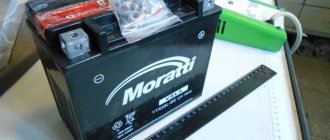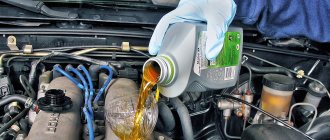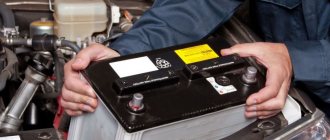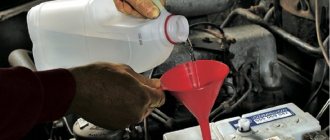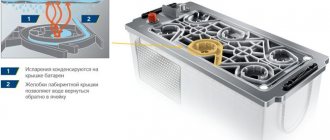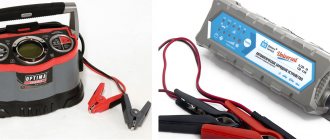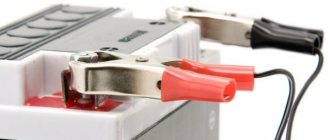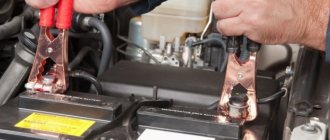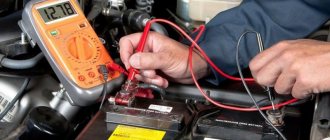Owners of serviced car batteries need to regularly monitor the level of electrolyte in them and, if necessary, add pure H2O, free of minerals and organic additives. This water is called distilled and is an important component of the battery fluid. Its task is to maintain the chemical composition of the electrolyte at an optimal level, thereby guaranteeing high-quality battery operation.
Before you find out how to properly pour purified liquid into the battery, it is important to remember that it is prohibited to use tap or boiled water for this purpose. They contain a lot of foreign impurities (iron, calcium, magnesium, chlorine), which are deposited on the metal plates of the battery during charging. This “scale” leads to a decrease in battery capacity and destruction of its plates. This changes the density of the electrolyte in the battery.
Where can I get distilled water?
Car owners can buy deeply purified water in a five-liter bottle or other container at a hardware store, supermarket (in the household appliances department), pharmacy or at a gas station in the auto cosmetics department; these outlets are supplied by trusted suppliers. The largest manufacturer and supplier of distilled water is. You can order and buy distilled water on this page. You can also get it in normal home conditions, using one of the traditional methods of cleansing.
The first method is evaporation. For it you will need a large saucepan that closes tightly with a lid, a glass container and a metal grid. A wire rack is placed in the pan and then filled halfway with plain water. The glass container is placed on the grill so that its neck rises above the water. The pan is tightly closed with a lid and put on gas. Ice is placed on top of it. The water boils, condenses on the cooled lid and is collected in a glass container.
The second method is freezing. To do this, running water is poured into a plastic bottle and placed in the freezer. After half the liquid turns into ice, the unfrozen water is drained from the bottle and the remaining ice is melted. This is the distillate.
And the easiest way is to collect rainwater, which is a natural distillate. True, in large cities it has too high a percentage of acidic impurities, which makes it unsuitable for use in a battery.
When is it better to fill the distillate - before or after charging the battery?
You need to pour distilled water into the battery before charging the battery.
This will allow you to adjust the liquid level in each jar and bring it to the same level.
During the subsequent charging of the battery, each plate will be charged evenly, and at the end of charging, topping up the distillate will not be required.
The charging process does not regulate the density of the electrolyte, therefore, by adding water before recharging the battery, it is necessary to achieve a liquid density of 1.28 kg/m3. (deviations are permissible by no more than 0.01 kg/m3). After recharging, the battery will be ready for use.
Correctly pour distilled water into the car battery
The service life of the car battery and the serviceability of the car’s electrical network depend on how correctly we pour the distillate into the car’s battery. By maintaining the sequence of actions, we thereby extend the life of the battery.
1. Place the battery strictly horizontally. Otherwise, you will either overfill the water or not add it due to the fact that there will be different levels of liquid in the jars.
2. Wipe the surface of the battery around the edges of the plugs to remove any dirt.
3. Dip a rag in the soda solution and wipe the necks of the jars with it to neutralize the sulfuric acid that has accumulated there during the charging process.
4. Unscrew the caps, trying to prevent electrolyte from getting on your hands (it is better to wear gloves).
5. Fill a small rubber bulb with purified water and carefully pour it into each jar.
6. Inspect the electrolyte level in the jars - the battery fluid should be 1 cm above the top edge of the plates.
7. Simply remove excess liquid with a pear in the required volume.
8. Screw on the caps.
9. Charge the battery no earlier than after 3-4 hours.
How to add water to the battery
To properly fill water when the level in the jars drops, you need to unscrew the filler plugs and measure the current level. The amount of liquid above the surface of the plates should be within 10-15 mm. You can add water using a watering can or a clamp, and wipe off any water that gets on the surface of the battery with a dry cloth so that a conductive layer does not form, leading to increased self-discharge of the battery. Exceeding the level is also undesirable, since the density will decrease, and this is dangerous in winter. If the electrolyte boils during charging, it will splash out through the drainage holes, causing corrosion of the electrodes and metal parts of the car. Acid on the surface of the battery increases the self-discharge of the battery.
How much distilled water should be added?
The batteries of new models, made of translucent plastic, are quite easy to add water to. On their body there is a scale with the manufacturer’s recommended liquid level, which must be adhered to. The situation is more complicated with older type batteries. Here are some tips to help you cope with the task. If your battery has a small tongue below the neck of the cans (metal or plastic), then water should be added until the electrolyte level rises 5 mm above it. If there is no tongue, then you need to add distilled water until the electrolyte level rises 1 cm above the top of the plates.
And a few more important points: do not add water to the car's autonomous power supply if you have just turned off the engine. The battery must sit for several hours before it can be opened. In the same way, you cannot immediately turn on the internal combustion engine after adding distilled water to the battery. The battery must sit for at least a few hours, otherwise it may boil.
An excellent alternative to distillate is deionized water. It is purer than distilled water, more precisely 100 times more pure, and can also be used for filling into batteries.
When should electrolyte be added to the battery?
It is common knowledge that the electrolyte in a car battery consists of acid and distilled water. These liquids are mixed in different proportions and there are still significantly fewer acids. As an example, you need to obtain an electrolyte with a density of 1.28 g/cm³, then for this you will need to add 0.36 liters of battery acid to 1 liter of distilled water. That is, the ratio should be somewhere around 1 to 3.
For safety reasons, it is worth adding that you need to pour the acid into the water and not vice versa. Since there is a high probability of a chemical “response” from this mixture with the release of heat and splashes. There is no need to talk about the consequences of getting sulfuric acid on the skin or eyes. The whole point is that water is lighter in structure than acid, which means that mixing of liquids will occur very slowly.
It is the ratio of acid and water that is shown by a hydrometer - a device designed to determine the density of the electrolyte in the battery. When the density of the electrolyte becomes excessively low, it begins to hold a charge poorly. If, when checking the density, its values turn out to be slightly less than the required 1.25-1.30 g/cm³, it is still recommended to add electrolyte rather than water.
It is worth noting that the density of the electrolyte changes depending on the state of charge of the battery. That is why accurate indicators of the density of battery fluid can only be obtained on a fully charged battery. In addition, it is best to charge the battery with a weak current over several days!
Why is distilled water added to the car battery and what is it?
A certain amount of distilled water in the liquid inside the battery is a necessary component. It is this that ensures full operation of the battery, maintaining the optimal density of its electrolyte. It consists of 65% sulfuric acid, and the percentage of sulfuric acid in it should be much less - only 35%.
Since sulfuric acid is a useful, but very dangerous and highly concentrated chemical compound, purified water acts as a lowering level of its concentration to a useful one that will not harm the battery.
Moreover, the 65:35 ratio level in the battery precisely ensures the process of accumulating electrical energy inside it during the charging process. This energy will then be consumed when starting the engine and driving the car.
What is distilled water? This is a pure liquid that has been distilled, that is, purified. It consists of three atoms, two of which are hydrogen and the other oxygen, and does not contain any additional impurities, which may consist of salts and other substances .
Before you find out the answer to the question of how much distilled water to add to the battery, it is important to understand that you cannot pour ordinary water into the battery . A large level of impurities in the form of chlorine, salts and even lime, which will settle on the lead plates of the battery, will quickly lead to sulfation and failure.
Boiled water cannot be poured into the battery either : simple boiling without the use of certain technologies does not distill its composition properly. Simply taking and boiling water does not mean purifying it completely.
This is interesting: What is the efficiency of solar panels?
There is an opinion that distilled water can be prepared at home. But, since this process is quite labor-intensive and energy-consuming, it is best to purchase it in specialized stores, paying attention to the shelf life, which, on average, is about a year.
How long does it take and how to charge it correctly?
After keeping the battery in which distilled water and electrolyte were mixed for 3 hours, it must be charged.
to charge the battery after adding water is as follows:
- Prepare the battery for charging:
cleaning the terminals from oxides in order to ensure strong contact;
- cleaning the surface of the case from any remaining traces after filling the battery;
- removing the plugs and lids on each jar to once again ensure that the electrolyte level in each jar is normal;
- To avoid burns, you need to wear gloves, and it is advisable to wear safety glasses.
- Determine charging method. There are three main ways:
- DC charging is a fairly effective method, but difficult to implement;
- charging under constant voltage is a much simpler method, but less effective; the battery charge after completion does not exceed 80% of the nominal one;
- combined - special expensive equipment is required here, but the battery owner does not expend any additional effort.
- Charge the battery.
DC charging is a very effective way to charge your battery as much as possible. In this case, it takes a long time and constant monitoring of the charging process, but the result will be excellent.
It is possible to charge the battery to almost 100%. The time it takes to recharge is about 10 hours.
Charging under constant voltage is much easier to perform . Just set the voltage to 14.4 V and wait. This charging method will require almost a day and will charge the battery to almost 80% of its nominal value.
Charging in a combined way is carried out using a special device. “Smart” equipment will independently perform the entire range of actions to check the battery charge level, start the charging process and automatically supply the required voltage at the right time.
It prevents water from boiling away from the electrolyte and excessive current supply. The equipment is expensive. With such recharging, it will take up to 12 hours, depending on the degree of discharge .
How to disassemble a maintenance-free battery to add electrolyte
In modern batteries, such as VARTA, under the decorative sticker you can see 6 plates, tightly recessed into the case. If you pry the circle with an awl, you can find a rubber stopper underneath it. Then it will be possible to take a sample of the electrolyte, measure the density, and adjust the composition. If there is no stopper, a hole is made in each jar with a thin awl, and water is released from a syringe in drops.
But if it is found that there are whitish streaks on the plates in the jars, this is sulfation. To clean the cavities and remove sediment below, you will need to open the lid by sawing.
Watch the video on how to add electrolyte to a maintenance-free battery.
Add electrolyte to the gel battery
A maintenance-free gel battery is the same as a lead-acid battery, but the electrolyte has been thickened and is in the form of a gel. Over the years, electrochemical parasitic reactions produce hydrogen escaping from the rubber vent valve. The gel becomes dehydrated and no longer adheres tightly to the plates. The battery capacity decreases.
Adding water to the battery cans is easy. You need to remove the sticker on the body, remove the valve caps and drop 1.2 ml of water into each jar. The water should be absorbed into the jelly-like mass. Need time. After half an hour, if the water is above the surface of the battery plates, remove it with a filter or syringe.
The performance of an imported battery decreases after 5-6 years. The service life of Russian batteries is no more than two years. The deterioration of parameters is affected by various physical and chemical processes in the electrolyte, as a result of which its density changes, and, accordingly, the output current.
The problem can be dealt with by monitoring the fluid level in the battery banks. This is where motorists have questions, one of which is what to add to the battery, water or electrolyte. We will tell you in which cases it is necessary to top up with distilled water, and in which - with an electrolytic solution, and we will provide information on the maximum permissible parameters of the battery.
